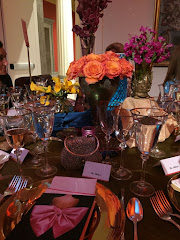During the finale of Downton Abbey last week, Lord Grantham mentioned he had received a "Bread and Butter Letter" from a guest from a past house party. Sounds charming, doesn't it? In his tone, Lord Grantham intimated this letter, an expected social formality, was boringly obligatory, like bread with dinner, but would have been missed if it had not been on the table. What is a "Bread and Butter Letter" and where did this expression come from?
To begin, the "Bread and Butter Letter" is simply a simple, and commonly written, thank you note for hospitality. It is written to the Host and Hostess to thank them for a special dinner, evening or weekend at their home. Maybe you attended one of those those famous Edwardian country "Weekend Shooting Parties" we've seen on Downton Abbey!
The humble "Bread and Butter Letter" like any other Thank-You note, is always hand written within 24 hours, or as my Grand Mother would say: "Before you go to bed." The note is immediately put in the mail. Snail mail, not E-mail. E-mail is not acceptable. Not even an E-mail saying a proper paper B&B note is on the way.
Don't forget to spread on your buttery bread letter, how delicious the food tasted, how lovely the view from the back lawn looked, and any other special details you participated in, such as a card game, a service or a celebration. Be sure to include how you were honored to be included, and how much you value the friendship and kind generosity of your hosts.
This basic social formality is also referenced in the 1926 British book: "Lady Troubridge's Book of Etiquette."
In closing, remember to break your bread over your Bread and Butter Plate in order to avoid crumbs all over the table, then butter your bread one piece at a time. Eat and enjoy!
Friday, February 28, 2014
Saturday, February 1, 2014
The Book: Visible City, is a Sparkling Stained-glass Jewel of a Story
Tova Mervis, author of "Visible City" fluidly vacillates like a kaleidoscope between her myriad of characters, painting their true life portraits, and masterfully piecing together their pasts, present fears, needs, and future hopes, like an opalescent John LaFarge stained-glass window. With the change of daylight, the characters morph from the red hot glow of the Noon sun to the cool blue hue of the full moon.
Unfulfilled Nina leers out her Living Room window looking at other people's lives.
Jeremy works late at a job he hates, but in the evenings, scavenges the underground "Ghost Subways" for lost treasures.
Leon, a lonely psychiatrist, longingly gazes at Nina in a coffee shop, as her children run around yelling and screaming despite a sign asking: "Children of All Ages Are Reminded to Use Their Inside Voices."
Claudia spends her time researching John LaFarge stained-bless windows, yet screams out her own window at the construction workers below.
Emma, Claudia's daughter, fears she will end up like her Mother.
Perfect Wendy, whose mother was a screamer, is scared she cannot control her children, and is scared they will discover her secret unhappiness as a 'Stay-at-home-Mom.'
Like an antique stained-glass window, Tova Mervis shows us what happens when marriages gather dust; careers show cracks and fissures, and what transpires when we want to use our outside voices. We can't always be stuck inside the metal constraints of life. Sometimes we need to find out what makes our hearts glow.
This review is posted on line with Real Simple Magazine at: www.realsimple.com/work-life/entertainment/best-books-2014-00100000117742/page7.html
Unfulfilled Nina leers out her Living Room window looking at other people's lives.
Jeremy works late at a job he hates, but in the evenings, scavenges the underground "Ghost Subways" for lost treasures.
Leon, a lonely psychiatrist, longingly gazes at Nina in a coffee shop, as her children run around yelling and screaming despite a sign asking: "Children of All Ages Are Reminded to Use Their Inside Voices."
Claudia spends her time researching John LaFarge stained-bless windows, yet screams out her own window at the construction workers below.
Emma, Claudia's daughter, fears she will end up like her Mother.
Perfect Wendy, whose mother was a screamer, is scared she cannot control her children, and is scared they will discover her secret unhappiness as a 'Stay-at-home-Mom.'
Like an antique stained-glass window, Tova Mervis shows us what happens when marriages gather dust; careers show cracks and fissures, and what transpires when we want to use our outside voices. We can't always be stuck inside the metal constraints of life. Sometimes we need to find out what makes our hearts glow.
This review is posted on line with Real Simple Magazine at: www.realsimple.com/work-life/entertainment/best-books-2014-00100000117742/page7.html
Subscribe to:
Posts (Atom)









